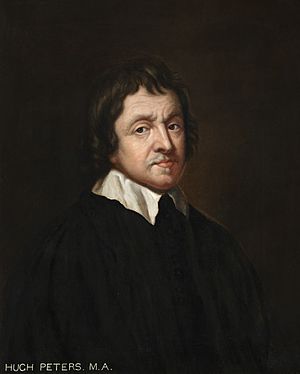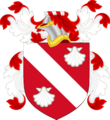Hugh Peter facts for kids
Quick facts for kids
Hugh Peter
|
|
|---|---|
 |
|
| Born | 29 June 1598 |
| Died | 16 October 1660 (aged 62) Charing Cross London
|
| Cause of death | Execution by hanging, drawing and quartering |
| Education | Trinity College, Cambridge |
| Occupation | Independent Preacher |
| Known for | Chaplain in New Model Army, Parliamentarian, regicide, New England colonist |
Hugh Peter (or Peters) (born 29 June 1598 – died 16 October 1660) was an English preacher and advisor. He played a big part in the English Civil War, supporting the Parliament's side. He was known for his exciting way of speaking, which helped the Puritan cause.
Peter came from a strong Protestant family in Cornwall, England. He moved to a Puritan colony in America, where he became well-known. After living in Holland, he returned to England. He became a close friend and supporter of Oliver Cromwell. Some people believe Peter was the first to suggest the execution of Charles I, and he was thought to have helped at the beheading.
Peter tried to make big changes, like changing how the Church of England owned land. He disagreed with the war against Protestant Holland. After Cromwell died, Peter's strong opinions put him in danger. When the king returned to power during the Restoration, Peter was executed for his role in the king's death.
Contents
Early Life and Travels
Hugh Peter was born in Fowey, Cornwall, in 1598. His father was from Antwerp, and his family was wealthy. He studied at Trinity College, Cambridge. After becoming a preacher, he worked in Essex and then London. He became a lecturer at St Sepulchre's church. However, he had Puritan beliefs, which were different from the main church. Because of this, he moved to Holland. He visited Gustavus Adolphus of Sweden around 1632 and later became a minister in Rotterdam.
His Puritan ideas again caused attention, so Peter moved to New England in America. He arrived in Boston in 1635 and became the leader of the church in Salem. He was involved in important events, like the trial of Anne Hutchinson in 1637. He also helped start the new colony in Connecticut and played a role in creating Harvard College.
Role in the English Civil War
In 1641, Peter returned to England to help the colony. But he quickly got involved in the political problems that led to the Civil War. He became a chaplain for the Parliament's army. He helped explain Parliament's side to the Dutch and raise money for them.
Peter was very good at giving sermons that encouraged people to join the Parliament's army. He also spoke at the executions of state criminals. But he was most important as an army chaplain. He joined the Earl of Warwick in 1644 to help Lyme. He then worked with Sir Thomas Fairfax and the New Model Army. Before battles, he would preach to the soldiers, and his words were said to inspire them at places like Bridgwater and Bristol. After victories, he helped convince people to support Parliament.
Peter also acted as a special messenger for the army generals. He would report to Parliament about the army's condition and successes. His stories of battles were very popular. Oliver Cromwell also used Peter to report on victories like the capture of Winchester. In 1646, he gave a special sermon to Parliament to celebrate the army's success in the west of England.
Influence and Support for Cromwell
After the First English Civil War, Peter became very influential among the Independents, a group with strong religious beliefs. In his writings, he asked for religious freedom and alliances with other Protestant countries. He supported the New Model Army in its disagreements with Parliament. He even met with King Charles I in 1647.
During the Second English Civil War, Peter helped get guns for sieges and raised troops. He supported the army's actions in London in 1648. In 1649, he went with Cromwell on his campaign in Ireland. He helped send supplies and soldiers from England to Cromwell. In 1650, he became a chaplain for the Council of State, influencing religious and legal changes. He was also present at the Battle of Worcester in 1651, where he preached to the winning soldiers.
Role in the King's Trial
Peter was involved in bringing King Charles I to London as a prisoner. He publicly supported the king's trial and sentence in his sermons. Peter's advice was important to Cromwell's inner circle and influenced major decisions. Some witnesses said Peter was the first to suggest that the king should be tried and executed.
Life Under the Commonwealth
After the war, Peter became a very influential person. Parliament gave him money each year, and he received part of Archbishop Laud's library. He was part of a group that suggested legal changes. He wrote about his ideas, which included keeping records of wills and land titles. He did not agree with the First Anglo-Dutch War, which hurt his influence. In 1658, he went to Dunkirk as a chaplain. He gave the funeral sermon for Oliver Cromwell and opposed the removal of Richard Cromwell.
In 1647, Peter had asked for Jewish people to be allowed back into England. He believed it would help the economy and bring about the Second Coming. Cromwell invited him to a meeting in 1655 to discuss this. However, at the meeting, Peter changed his mind, saying that Jewish people might not convert and could cause harm.
Restoration and Final Years
After Cromwell's son lost power, the country became unstable. General Monck marched to London, and Peter tried to gain his favor but was unsuccessful. When King Charles II was restored to the throne, Peter was in great danger. His arrest was ordered, and his property was taken. He was arrested in September 1660.
Peter was well-known for speaking out against the royal family. He tried to deny his part in King Charles I's death. However, he was accused of supporting the king's execution. Witnesses claimed he was present at the execution scene. He was found guilty of high treason on October 13. Peter wrote a book called "A Dying Father's Last Legacy" for his daughter, Elizabeth, telling his life story.
Execution
Hugh Peter was sentenced to death. His execution took place at Charing Cross on October 16, 1660.
About Hugh Peter
Historians have different views on Hugh Peter. Some say he was a rough and outspoken man who was very active in his cause. They believed his energy sometimes got him into trouble. Others, like historian C. H. Firth, thought that the strong dislike for Peter was not fully deserved. Firth believed Peter was an honest and kind man. His strong words and actions might have caused people to dislike him, but his efforts for the public good were often forgotten.
Peter was described as tall and thin by some, but his portraits show a fuller face. Many pictures and satirical drawings of him exist.
Family Life
Hugh Peter's family came from the Netherlands, having left to escape religious persecution. His mother was Martha Treffry from Cornwall.
Around 1625, Peter married Elizabeth, a widow from Essex. Later, he married Deliverance Sheffield. She was still alive in New England in 1677. Peter had one daughter, Elizabeth, from his second marriage. His book "A Dying Father's Last Legacy" was written for her.
Hugh Peter in Movies and TV
- In the 1970 film Cromwell, Peter was played by Patrick Magee.
- He was the subject of a 1981 TV play called A Last Visitor for Mr. Hugh Peter. It showed him the night before his execution, meeting people from his past and future. Peter Vaughan played Hugh Peter.
Images for kids
See also





